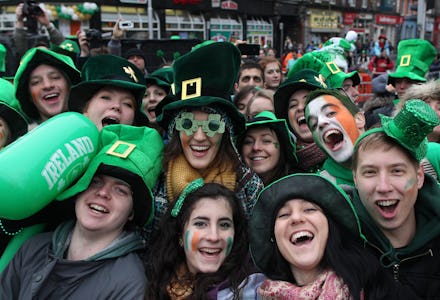11 Actual Facts About Being Irish That Have Nothing to Do With Alcohol

March 17 marks the death of St. Patrick, more affectionately known today as the saint who gave us an excuse to get plastered on green beer once a year.
God love ya, Irish-Americans, but despite the stereotypes, there's a lot more to being Irish than drinking Guinness. According to the U.S. Census, about 34 million Americans claim Irish ancestry — including President Barack Obama. As Reuters reported in 2011, the president's great-great-great grandfather, Fulmoth Kearney, a shoemaker from Moneygall, "left [Ireland] in 1850 to begin a new life in the United States."
If you want to be more than a Plastic Paddy this year, here are some facts about being Irish that are actually worth celebrating.
1. The Irish won their independence from England in 1922.
Countless wars punctuate Ireland's history. When Ireland got the upper hand on a war-fatigued England in 1919, the "Irish War of Independence" was born. The war ended in 1921 and Ireland claimed independence in 1922.
2. Irish was made the country's official language in order to solidify and foster its heritage.
To keep Irish culture alive, children are required to study the language in primary and secondary school.
2. Ireland has a unique national sport.
Hurling — which is not a synonym for puking — is one of two national sports. This ancient Gaelic game, which has written accounts dating it to at least the 7th century, is like field hockey... but in the air.
3. The Irish have faced centuries of racism.
While not something to celebrate, it is important to remember the prejudices Irish men and women have faced throughout history. Anti-Irish sentiment in the U.S. was strong throughout the 19th and 20th centuries, especially after the large influx of immigrants due to the Irish Potato Famine in the 1840s and early 1850s. Xenophobia reigned supreme, and the Irish faced systemic racialized oppression.
This history politically aligned the Irish with the African-American community, at least until the Civil Rights Movement of the mid-20th century, with the Irish labeled "white negroes" and the blacks "smoked Irish."
4. The first St. Patrick's Day parade took place in the U.S. — not Ireland.
While St. Patrick has been known for centuries as the nation's patron saint, Ireland was not the first to hold a parade in his honor: New York City was. The city held the first St. Patrick's Day Parade in 1762 when, according to the History Channel, "Irish soldiers serving in the English military" marched through the city.
In fact, many cities and town in Ireland don't have parades, and those that do, like Dublin, hold them as "sober" events.
5. Ironically, St. Patrick was not Irish.
He was born in Britain in the 5th century and was of Romano-British descent. According to legend, he was brought to Ireland by Irish pirates who invaded his town and made him a slave.
He most likely did not banish snakes from Ireland either.
6. Less than 70 years after independence, Ireland elected its first female president.
The Labour Party's Mary Robinson made history in 1990 when she was elected the first female president of Ireland, and the seventh president in Ireland's history. In terms of America's history, that would be like if Andrew Jackson were Andrea Jackson. Robinson resigned in 1997 to accept her appointment as United Nations High Commissioner for Human Rights. Her career of fighting for human rights and especially for women's and worker's rights earned her the U.S. Presidential Medal of Freedom in 2009.
7. Irish writers helped usher in literary modernism.
Wilde, Joyce, Yeats, Beckett – literary modernism was crafted in large part by these writers, dramatists and poets. C.S. Lewis, author of The Chronicles of Narnia, was also Irish, and there were countless others, like Louise Bogan and F. Scott Fitzgerald, of Irish descent who revolutionized literature.
8. Irish culture gave us the Lord of the Dance...
Derived from traditional Irish dance, Michael Flatley's take on modern step dancing created a global sensation epitomized by stage shows like Riverdance and Lord of the Dance.
9. ...As well as arguably the best satirical show about priests ever made, Father Ted.
Ireland's greatest contribution to pop culture (kidding, kind of) didn't originally air in the country. Father Ted, the satirical show about three Catholic priests banished to Craggy Island as punishment for their religious transgressions, was created by Irish writers Arthur Mathews and Graham Linehan. While only consisting of 25 episodes, the show has immortalized a number of cultural references. With plot lines making fun of everything from the Catholic Church to "rough-and-tumble homosexual activity," Father Ted generated plenty of controversy, and was even banned in Boston.
10. Ireland has free education — including college — for its citizens.
As Ireland's Citizens Information Board outlines, "The Irish education system is made up of primary, second, third-level and further education. State-funded education is available at all levels, unless you choose to send your child to a private institution." In America, by contrast, the National Center for Education Statistics reported the average tuition at a four-year college is $29,408.